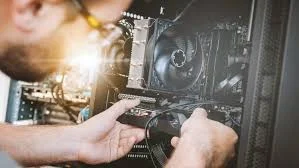Introduction
Welcome to “Hardware Heroes”, where we unravel the mysteries of computer components. Join us on a fascinating exploration as we delve into the essential hardware that powers your digital world.
The Central Processing Unit (CPU)
The Brain of Your Computer: Understanding CPUs
Embark on a journey into the heart of your computer with the Central Processing Unit (CPU). Explore the role of the CPU in executing instructions, processing data, and driving overall system performance.
CPU Architecture: From Cores to Clock Speeds
Delve deeper into CPU architecture, from the number of cores to clock speeds and cache sizes. Discover how these specifications impact the CPU’s capabilities and determine its performance in various tasks.
Graphics Processing Unit (GPU)
Powering Visuals: Unleashing the Potential of GPUs
Enter the realm of Graphics Processing Units (GPUs) and unlock their role in rendering stunning visuals and accelerating graphics-intensive tasks. Explore how GPUs revolutionize gaming, multimedia, and scientific computing.
GPU Architectures: Parallel Processing and CUDA Cores
Discover the inner workings of GPU architectures, designed for parallel processing and equipped with specialized CUDA cores. Learn how GPUs excel at handling massive datasets and complex computations.
Random Access Memory (RAM)
Memory Magic: Exploring the World of RAM
Dive into the realm of Random Access Memory (RAM) and uncover its crucial role in storing temporary data for fast access by the CPU. Learn how RAM impacts system responsiveness and multitasking capabilities.
RAM Types: DDR4, DDR5, and Beyond
Explore the evolution of RAM technology, from DDR4 to the latest DDR5 standards. Understand the differences in speed, bandwidth, and power efficiency, shaping the future of memory performance.
Storage Solutions
Beyond Speed: Navigating Storage Options
Navigate the diverse landscape of storage solutions, from traditional Hard Disk Drives (HDDs) to modern Solid State Drives (SSDs) and emerging technologies like NVMe SSDs. Explore the trade-offs between speed, capacity, and cost.
Storage Interfaces: SATA, PCIe, and M.2
Uncover the various storage interfaces powering your storage devices, including SATA, PCIe, and M.2. Learn how these interfaces impact data transfer speeds and compatibility with your system.
FAQs
- What is the role of the CPU in a computer?
The CPU serves as the brain of the computer, executing instructions, performing calculations, and coordinating system operations. - How do GPUs differ from CPUs?
GPUs specialize in parallel processing and excel at rendering graphics and handling complex computations, whereas CPUs focus on general-purpose tasks and single-threaded performance. - Why is RAM important for computer performance?
RAM plays a crucial role in providing fast access to data for the CPU, enhancing system responsiveness and multitasking capabilities. - What are the advantages of SSDs over HDDs?
SSDs offer significantly faster read and write speeds, lower latency, and better durability compared to traditional HDDs, resulting in improved system performance and faster boot times. - How do storage interfaces affect performance?
Storage interfaces like SATA, PCIe, and M.2 determine the data transfer speeds between storage devices and the rest of the system, impacting overall storage performance and responsiveness. - What factors should I consider when upgrading my computer’s hardware?
When upgrading hardware components, consider factors such as compatibility with your system, performance requirements, and budget constraints to ensure optimal performance and value.
Conclusion
“Hardware Heroes” has unveiled the essential components that power your computer’s performance, from the mighty CPU to the speedy SSD. By understanding the role and capabilities of each hardware hero, you can optimize your system for peak performance and efficiency.
